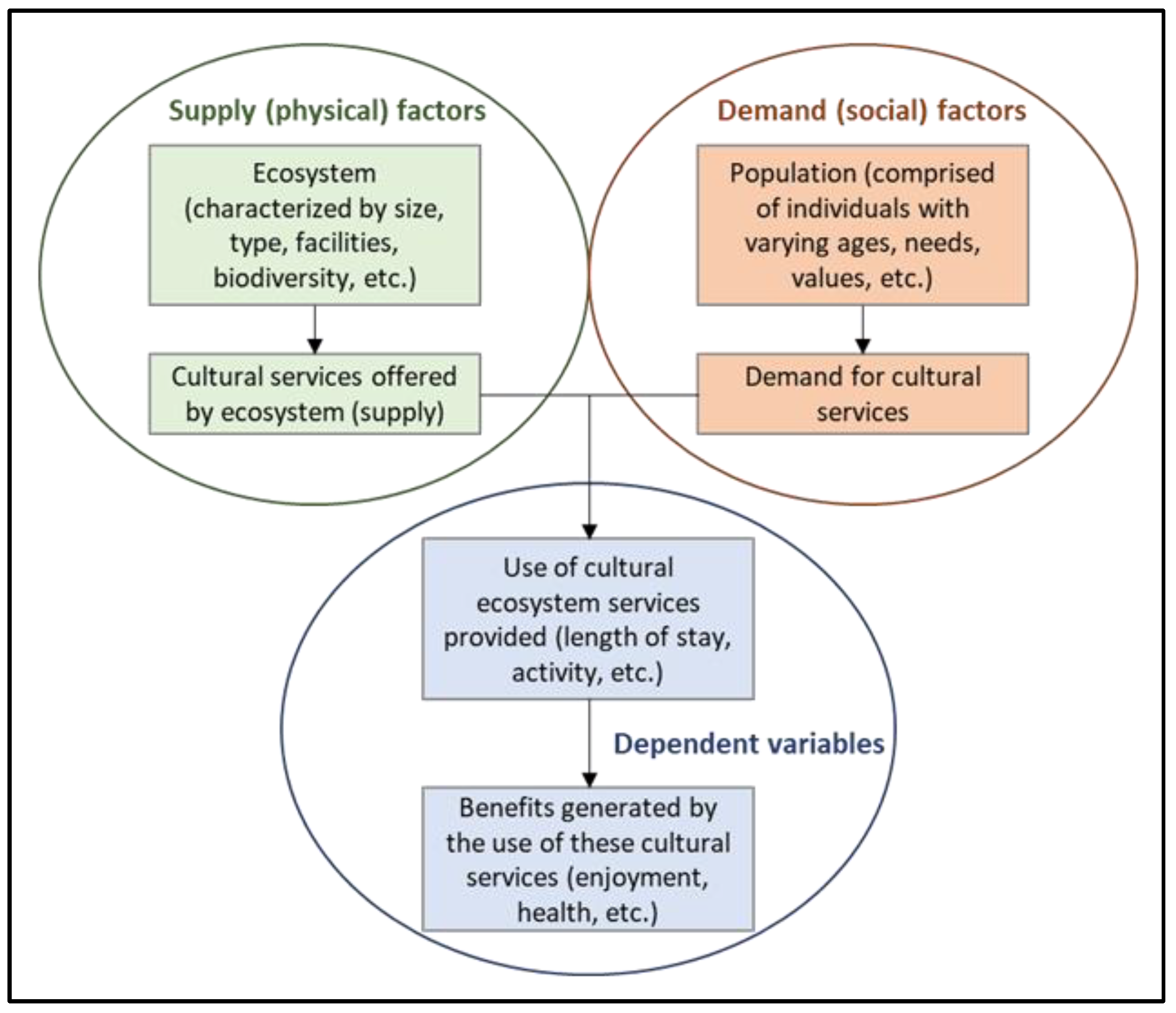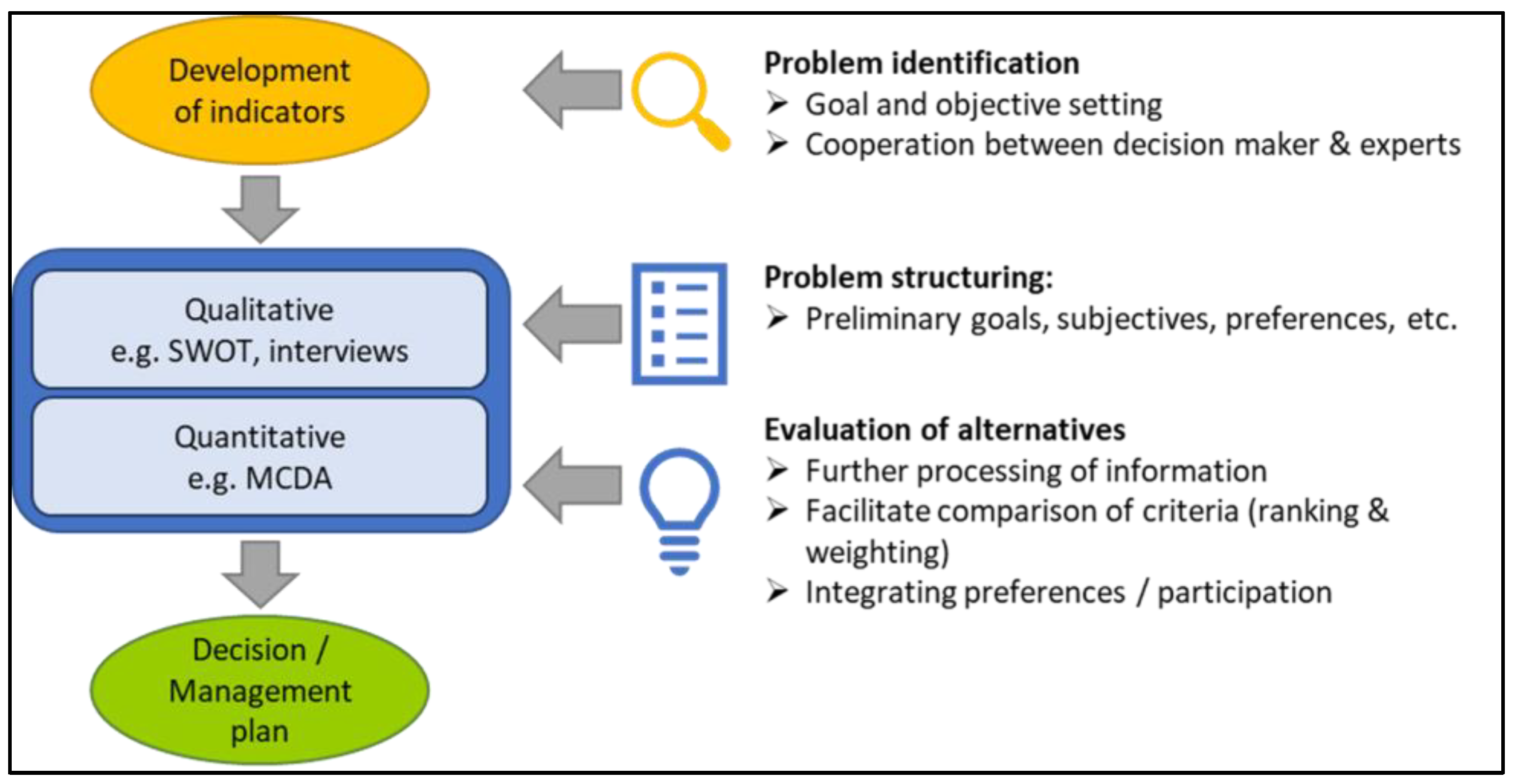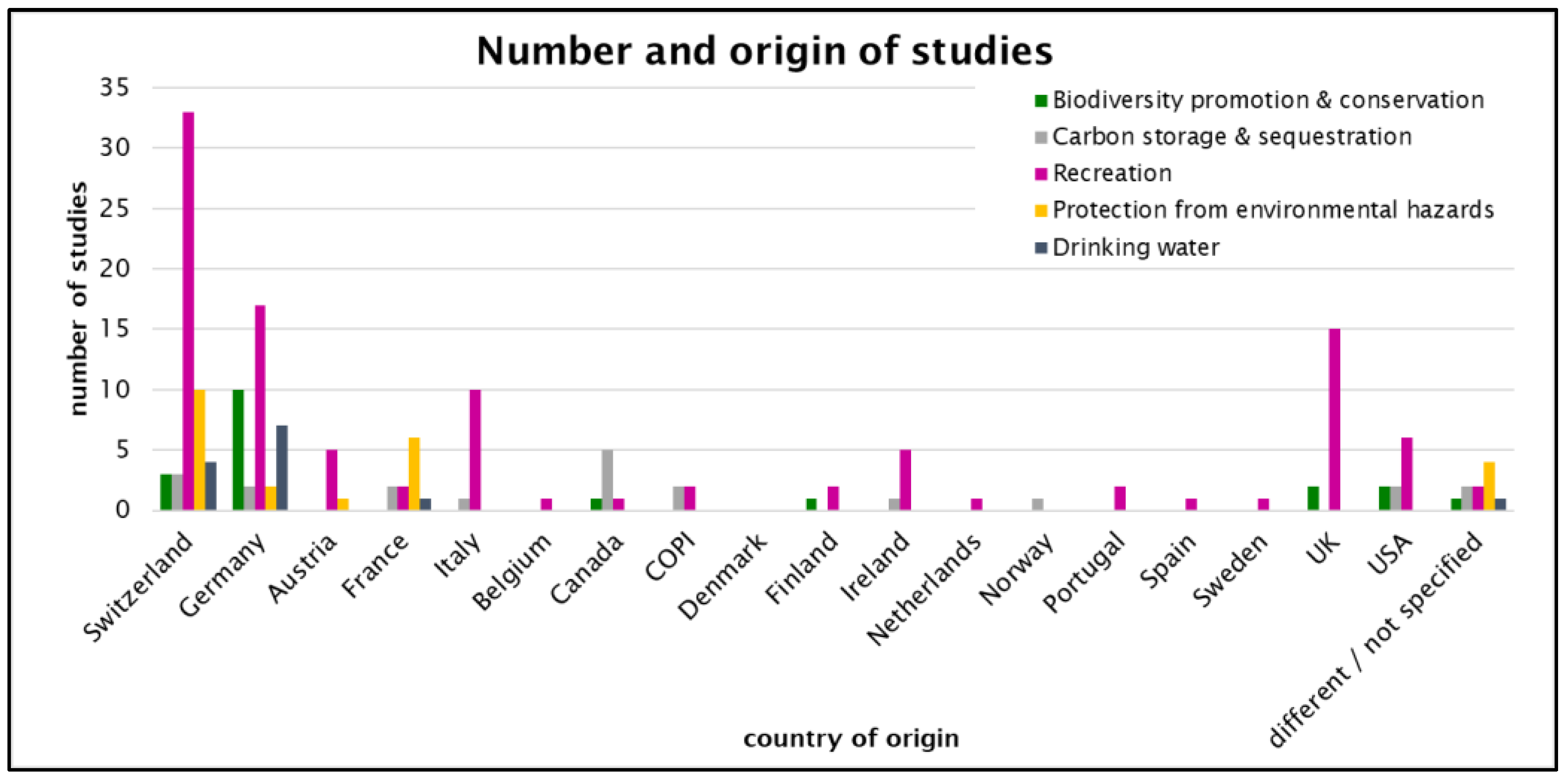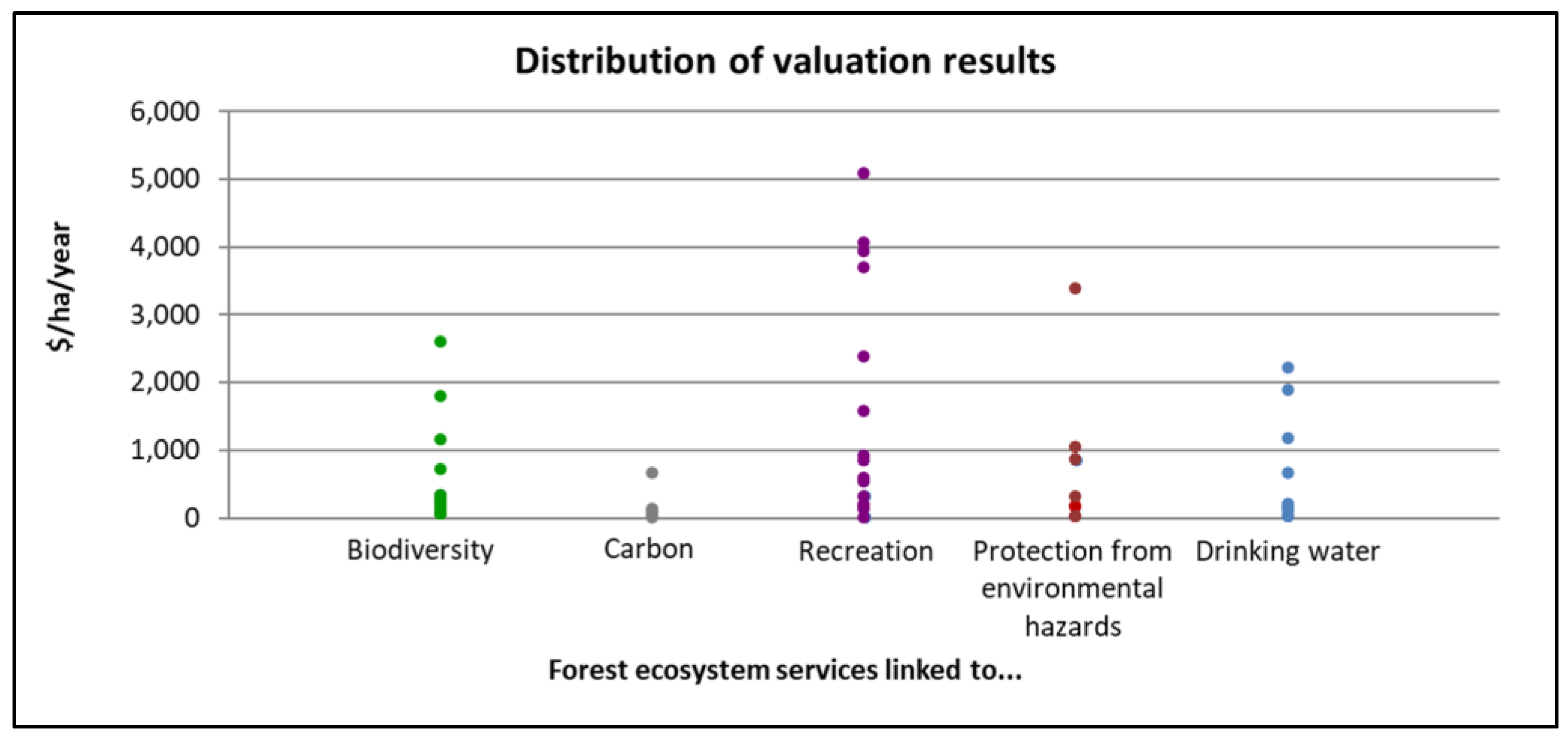Can Existing Estimates for Ecosystem Service Values Inform Forest Management?
Abstract
:1. Introduction
- Assessing and evaluating the impact of alternative actions and therefore serving as a decision support instrument to assess whether an intervention is economically reasonable.
- Examining the distribution of costs and benefits generated by an ecosystem or intervention to identify winners and losers and allocate scarce resources among competing demands.
- Identifying potential financing sources, e.g., for conservation purposes to help make them financially sustainable.
- Providing a tool for improving decision-making processes.
2. Methods: Integration of ES in Decision Making, Analysis of Secondary Data, and Transferability of Results
2.1. Valuation of ES
2.1.1. Travel Cost Method (TCM)
2.1.2. Hedonic Pricing (HP)
2.1.3. Contingent Valuation Method (CVM)
2.1.4. Choice Experiments (CE)
2.1.5. Benefit Transfer (BT)
- The specific services in question (extent, quality) and type of change that was analyzed (e.g., marginal improvement or avoidance of deterioration).
- The valuation question: willingness to pay (e.g., to avoid negative changes or achieve positive changes) or willingness to accept (e.g., to accept a negative change or the non-occurrence of a positive change).
- The addressee of the study (national, regional, or local sample; private persons, enterprises, or experts).
- The characteristics of the population.
- The geographical location.
- The time the survey was conducted (considering inflation and changes in exchange rates).
- Scaling: Unit values must be adjusted when they are transferred to larger geographic areas or scales [46].
- Site, context, and commodity similarity, e.g., the similarity between available substitutes and complements of the good or service in question.
- Additional challenges for international BT, e.g., currency conversion, user attributes.
- Accurate understanding of welfare-influencing quantities and qualities of goods at affected sites.
- Data sources and selectivity: It is necessary that the primary studies are of high quality (e.g., appropriate reporting of data and methods) and offer an unbiased sample of the population’s empirical estimates; these in turn must provide an unbiased representation of true resource values.
- Biodiversity promotion and conservation
- Carbon sequestration and storage
- Recreation
- Protection from natural hazards
- Quality and quantity of drinking water
2.2. Data Collection
- Biodiversity promotion and conservation: 2008–2015
- Carbon sequestration and storage: 2001–2016
- Recreation: 2001–2016
- Protection from natural hazards: 2009–2015
- Quality and quantity of drinking water: 2009–2014
3. Results
3.1. Biodiversity Promotion and Conservation
3.2. Carbon Sequestration and Storage
3.3. Recreation
- Type of recreation (e.g., biking, walking, etc.)
- Infrastructure and substitutes in the area (e.g., existing recreational facilities such as bike trails, fireplaces, etc.)
- Distance to areas of high population density (e.g., cities, hotspots for tourism, etc.)
- Personal interests (e.g., existence of a forest essential or less important to recreation)
- Conflicting elements (e.g., use intensity and diversity of type, number, and size of user groups (bikers, hikers, horseback riders))
3.4. Protection from Natural Hazards
3.5. Drinking Water Quality and Quantity
4. Discussion and Conclusions
- Change in land use
- Change in management objective
- Technical versus nature-based solutions
- Use of natural resources
- Management of conflict species
Author Contributions
Funding
Conflicts of Interest
Appendix A
| EUR– USD | CHF– USD | ATS– USD | DM– USD | CAD– USD | USD– USD (Inflation) | |
|---|---|---|---|---|---|---|
| 1980 | 0.60 | 0.08 | 0.55 | 2.97 | ||
| 1981 | 0.51 | 0.06 | 0.44 | 2.69 | ||
| 1982 | 0.49 | 0.06 | 0.41 | 2.53 | ||
| 1983 | 0.48 | 0.06 | 0.39 | 2.46 | ||
| 1984 | 0.43 | 0.05 | 0.35 | 2.35 | ||
| 1985 | 0.41 | 0.05 | 0.34 | 2.27 | ||
| 1986 | 0.56 | 0.06 | 0.46 | 2.23 | ||
| 1987 | 0.67 | 0.07 | 0.56 | 2.15 | ||
| 1988 | 0.69 | 0.08 | 0.57 | 2.07 | ||
| 1989 | 0.61 | 0.07 | 0.53 | 1.97 | ||
| 1990 | 0.72 | 0.09 | 0.62 | 1.87 | ||
| 1991 | 0.70 | 0.09 | 0.60 | 1.80 | ||
| 1992 | 0.71 | 0.09 | 0.64 | 1.74 | ||
| 1993 | 0.68 | 0.09 | 0.61 | 1.69 | ||
| 1994 | 0.73 | 0.09 | 0.62 | 1.65 | ||
| 1995 | 0.85 | 0.10 | 0.71 | 1.60 | ||
| 1996 | 0.81 | 0.10 | 0.67 | 1.56 | ||
| 1997 | 0.69 | 0.08 | 0.58 | 1.52 | ||
| 1998 | 0.69 | 0.08 | 0.57 | 1.50 | ||
| 1999 | 1.07 | 0.67 | 0.08 | 0.55 | 0.67 | 1.47 |
| 2000 | 0.92 | 0.59 | Newer values in EUR | 0.47 | 0.67 | 1.42 |
| 2001 | 0.90 | 0.59 | 0.46 | 0.65 | 1.38 | |
| 2002 | 0.95 | 0.64 | Newer values in EUR | 0.64 | 1.36 | |
| 2003 | 1.13 | 0.74 | 0.72 | 1.33 | ||
| 2004 | 1.24 | 0.81 | 0.77 | 1.29 | ||
| 2005 | 1.24 | 0.80 | 0.83 | 1.25 | ||
| 2006 | 1.26 | 0.80 | 0.88 | 1.21 | ||
| 2007 | 1.37 | 0.83 | 0.94 | 1.18 | ||
| 2008 | 1.47 | 0.93 | 0.94 | 1.14 | ||
| 2009 | 1.39 | 0.92 | 0.88 | 1.14 | ||
| 2010 | 1.33 | 0.96 | 0.97 | 1.12 | ||
| 2011 | 1.39 | 1.13 | 1.01 | 1.09 | ||
| 2012 | 1.28 | 1.07 | 1.00 | 1.07 | ||
| 2013 | 1.33 | 1.08 | 0.97 | 1.05 | ||
| 2014 | 1.33 | 1.09 | 0.91 | 1.03 | ||
| 2015 | 1.11 | 1.04 | 0.78 | 1.03 | ||
| 2016 | 1.11 | 1.02 | 0.76 | 1.02 | ||
| 2017 | 1.07 | 1.00 | 0.75 | 1.00 |
References
- Helm, D.; Hepburn, C. The economic analysis of biodiversity: An assessment. Oxf. Rev. Econ. Policy 2012, 28, 1–21. [Google Scholar] [CrossRef]
- Pagiola, S.; von Ritter, K.; Bishop, J. Assessing the Economic Value of Ecosystem Conservation: The World Bank Environment Department; Environment Department Paper No. 101; The World Bank: Washington, DC, USA, 2004. [Google Scholar]
- Merlo, M.; Croitoru, L. Concepts and Methodology: A First Attempt Towards Quantification: Chapter 3. In Valuing Mediterranean Forests: Towards Total Economic Value; Merlo, M., Croitoru, L., Eds.; CABI Publishing: Wallingford, UK, 2005; pp. 17–36. [Google Scholar]
- Milcu, A.I.; Hanspach, J.; Abson, D.; Fischer, J. Cultural ecosystem services—A literature review and prospects for future research. Ecol. Soc. 2013, 18, 44. [Google Scholar] [CrossRef]
- Andersen, H.B.; Klinker, C.D.; Toftager, M.; Pawlowski, C.S.; Schipperijn, J. Objectively measured differences in physical activity in five types of schoolyard area. Landsc. Urban Plan. 2015, 134, 83–92. [Google Scholar] [CrossRef]
- Pearce, D.W. The Economic Value of Forest Ecosystems. Ecosyst Health 2001, 7, 284–296. [Google Scholar] [CrossRef]
- Bagdon, B.A.; Huang, C.-H.; Dewhurst, S. Managing for ecosystem services in northern Arizona ponderosa pine forests using a novel simulation-to-optimization methodology. Ecol. Model. 2016, 324, 11–27. [Google Scholar] [CrossRef]
- Ferrier, S.; Ninan, K.N.; Leadley, P.; Alkemande, R.; Akçakaya, H.R.; Brotons, L.; Cheung William, W.L.; Christensen, V.; Harhash, K.A.; Kabubo-Mariara, J.; et al. The Methodological Assessment Report on Scenarios and Models of Biodiversity and Ecosystem Services; Secretariat of the Intergovernmental Science-Policy Platform on Biodiversity and Ecosystem Services: Bonn, Germany, 2016. [Google Scholar]
- Diaz-Balteiro, L.; Alonso, R.; Martínez-Jaúregui, M.; Pardos, M. Selecting the best forest management alternative by aggregating ecosystem services indicators over time: A case study in central Spain. Ecol. Indic. 2017, 72, 322–329. [Google Scholar] [CrossRef]
- Ovando, P.; Caparrós, A.; Diaz-Balteiro, L.; Pasalodos, M.; Beguería, S.; Oviedo, J.L.; Montero, G.; Campos, P. Spatial Valuation of Forests’ Environmental Assets: An Application to Andalusian Silvopastoral Farms. Land Econ. 2017, 93, 87–108. [Google Scholar] [CrossRef]
- Federal Statistical Office (FSO). STAT-TAB—Interactive Tables. Available online: https://www.pxweb.bfs.admin.ch/pxweb/de/px-x-0703010000_106/-/px-x-0703010000_106.px/table/tableViewLayout2/?rxid=606bb117-c4e8-49df-80f2-72ffaf30017a (accessed on 8 January 2019).
- Roschewitz, A.; Holthausen, N. Wald in Wert setzen für Freizeit und Erholung: Situationsanalyse; Federal Office for the Environment (FOEN): Bern, Switzerland, 2007. [Google Scholar]
- Bennett, E.M.; Cramer, W.; Begossi, A.; Cundill, G.; Díaz, S.; Egoh, B.N.; Geijzendorffer, I.R.; Krug, C.B.; Lavorel, S.; Lazos, E.; et al. Linking biodiversity, ecosystem services, and human well-being: Three challenges for designing research for sustainability. Curr. Opin. Environ. Sustain. 2015, 14, 76–85. [Google Scholar] [CrossRef]
- Daw, T.M.; Hicks, C.C.; Brown, K.; Chaigneau, T.; Januchowski-Hartley, F.A.; Cheung, W.W.L.; Rosendo, S.; Crona, B.; Coulthard, S.; Sandbrook, C.; et al. Elasticity in ecosystem services: Exploring the variable relationship between ecosystems and human well-being. Ecol. Soc. 2016, 21. [Google Scholar] [CrossRef]
- Burkhard, B.; Kroll, F.; Nedkov, S.; Müller, F. Mapping ecosystem service supply, demand and budgets. Ecol. Indic. 2012, 21, 17–29. [Google Scholar] [CrossRef]
- Plieninger, T.; Dijks, S.; Otero-Rozas, E.; Bieling, C. Assessing, mapping, and quantifying cultural ecosystem services at community level. Land Use Policy 2013, 33, 118–129. [Google Scholar] [CrossRef]
- Hegetschweiler, K.T.; de Vries, S.; Arnberger, A.; Bell, S.; Brennan, M.; Siter, N.; Olafsson, A.S.; Voigt, A.; Hunziker, M. Linking demand and supply factors in identifying cultural ecosystem services of urban green infrastructures: A review of European studies. Urban For. Urban Green. 2017, 21, 48–59. [Google Scholar] [CrossRef]
- Wirtschafts-Lexikon, G.; Hadeler, T.; Winter, E. Vollständig überarb. und aktualisierte Aufl; Gabler: Wiesbaden, UK, 2000. [Google Scholar]
- Pascual, U.; Balvanera, P.; Díaz, S.; Pataki, G.; Roth, E.; Stenseke, M.; Watson, R.T.; Başak Dessane, E.; Islar, M.; Kelemen, E.; et al. Valuing nature’s contributions to people: The IPBES approach. Curr. Opin. Environ. Sustain. 2017, 26, 7–16. [Google Scholar] [CrossRef]
- Murphy, R.; Narkiewicz, V. Are Price, Quality, and Value Mutually Exclusive? J. Glob. Bus. Manag. 2012, 8, 40–48. [Google Scholar]
- Grutters, J.P.C.; Kessels, A.G.H.; Dirksen, C.D.; van Helvoort-Postulart, D.; Anteunis, L.J.C.; Joore, M.A. Willingness to accept versus willingness to pay in a discrete choice experiment. Value Health 2008, 11, 1110–1119. [Google Scholar] [CrossRef]
- Johnston, R.J.; Rosenberger, R.S. Methods, Trends an Controversies in Contemporary Benefit Transfer. J. Econ. Surv. 2009, 26, 1. [Google Scholar] [CrossRef]
- Mendoza, G.A.; Prabhu, R. Development of a methodology for selecting criteria and indicators of sustainable forest management: A case study on participatory assessment. Environ. Manag. 2000, 26, 659–673. [Google Scholar] [CrossRef]
- Uhde, B.; Hahn, W.A.; Griess, V.C.; Knoke, T. Hybrid MCDA Methods to Integrate Multiple Ecosystem Services in Forest Management Planning: A Critical Review. Environ. Manag. 2015, 56, 373–388. [Google Scholar] [CrossRef]
- Garcia-Gonzalo, J.; Bushenkov, V.; McDill, M.; Borges, J. A Decision Support System for Assessing Trade-Offs between Ecosystem Management Goals: An Application in Portugal. Forests 2015, 6, 65–87. [Google Scholar] [CrossRef]
- Perman, R. Natural Resource and Environmental Economics, 4th ed.; Addison Wesley: Harlow, UK, 2011. [Google Scholar]
- Diaz-Balteiro, L.; Romero, C. Making forestry decisions with multiple criteria: A review and an assessment. For. Ecol. Manag. 2008, 255, 3222–3241. [Google Scholar] [CrossRef]
- Marques, S.; Marto, M.; Bushenkov, V.; McDill, M.; Borges, J. Addressing Wildfire Risk in Forest Management Planning with Multiple Criteria Decision Making Methods. Sustainability 2017, 9, 298. [Google Scholar] [CrossRef]
- Borges, J.G.; Garcia-Gonzalo, J.; Bushenkov, V.; McDill, M.E.; Marques, S.; Oliveira, M.M. Addressing Multicriteria Forest Management with Pareto Frontier Methods: An Application in Portugal. For. Sci. 2014, 60, 63–72. [Google Scholar] [CrossRef]
- Marto, M.; Reynolds, K.; Borges, J.; Bushenkov, V.; Marques, S. Combining Decision Support Approaches for Optimizing the Selection of Bundles of Ecosystem Services. Forests 2018, 9, 438. [Google Scholar] [CrossRef]
- Belton, V.; Stewart, T.J. Multiple Criteria Decision Analysis; An Integrated Approach, [Second Print.]; Kluwer: Boston, MA, USA, 2002. [Google Scholar]
- Feizizadeh, B.; Blaschke, T. GIS-multicriteria decision analysis for landslide susceptibility mapping: Comparing three methods for the Urmia lake basin, Iran. Nat Hazards 2013, 65, 2105–2128. [Google Scholar] [CrossRef]
- Tóth, S.F.; McDill, M.E.; Rebain, S. Finding the Efficient Frontier of a Bi-Criteria, Spatially Explicit, Harvest Scheduling Problem. For. Sci. 2006, 52, 93–107. [Google Scholar] [CrossRef]
- Bateman, I.J.; Harwood, A.R.; Mace, G.M.; Watson, R.T.; Abson, D.J.; Andrews, B.; Binner, A.; Crowe, A.; Day, B.H.; Dugdale, S.; et al. Bringing ecosystem services into economic decision-making: Land use in the United Kingdom. Science (New York, N.Y.) 2013, 341, 45–50. [Google Scholar] [CrossRef] [PubMed]
- Lawler, J.J.; Lewis, D.J.; Nelson, E.; Plantinga, A.J.; Polasky, S.; Withey, J.C.; Helmers, D.P.; Martinuzzi, S.; Pennington, D.; Radeloff, V.C. Projected land-use change impacts on ecosystem services in the United States. Proc. Natl. Acad. Sci. USA 2014, 111, 7492–7497. [Google Scholar] [CrossRef] [PubMed]
- Hanley, N.; Barbier, E. Pricing Nature. Cost-Benefit Analysis and Environmental Policy; Edward Elgar: Cheltenham, UK, 2009. [Google Scholar]
- Pascual, U.; Muradian, R.; Brander, L.; Gómez-Baggethun, E.; Martín-Lopez, B.; Verma, M.; Armsworth, P.; Christie, M.; Cornelissen, H.; Eppink, F.; et al. The Economics of Valuing Ecosystem Services and Biodiversity: Chapter 5. In The Economics of Ecosystems and Biodiversity: Ecological and Economic Foundations; Kumar, P., Ed.; Routledge: New York, NY, USA, 2012; pp. 183–256. [Google Scholar]
- Heal, G.M.; Barbier, E.B.; Boyle, K.J.; Covich, A.P.; Gloss, S.P.; Hershner, C.H.; Hoehn, J.P.; Pringle, C.M.; Polasky, S.; Segerson, K.; et al. (Eds.) Valuing Ecosystem Services. In Committee on Assessing and Valuing the Services of Aquatic and Related Terrestrial Ecosystems; National Academies Press: Washington, DC, USA, 2004; 291p. [Google Scholar]
- Secretariat of the Convention on Biological Diversity SCBD. The Value of Forest Ecosystems; CBD Technical Series no. 4; CBD: Montreal, QC, Canada, 2001; p. 59. [Google Scholar]
- Elsasser, P. Umweltökonomische Bewertung der Ökosystemleistungen von Wäldern—Methodik und Anwendungsperspektiven. In Erfassung und Bewertung von Ökosystemdienstleistungen—Erfahrungen insbesondere aus Deutschland und Russland; BfN-Skripten 373; BfN (Bundesamt für Naturschutz): Bad Godesberg, Germany, 2014; pp. 278–292. [Google Scholar]
- Johnston, R.J.; Rolfe, J.; Rosenberger, R.S.; Brouwer, R. Introduction to benefit transfer methods. In Benefit Transfer of Environmental and Resource Values: A Guide for Researchers and Practitioners; Johnston, R.J., Rolfe, J., Rosenberger, R.S., Brouwer, R., Eds.; Springer: Berlin, Germany, 2015; pp. 19–59. [Google Scholar]
- Uhde, B.; Heinrichs, S.; Stiehl, C.R.; Ammer, C.; Müller-Using, B.; Knoke, T. Bringing ecosystem services into forest planning—Can we optimize the composition of Chilean forests based on expert knowledge? For. Ecol. Manag. 2017, 404, 126–140. [Google Scholar] [CrossRef]
- Czajkowski, M.; Ahtiainen, H.; Artell, J.; Meyerhoff, J. Choosing a Functional Form for an International Benefit Transfer: Evidence from a Nine-country Valuation Experiment. Ecol. Econ. 2017, 134, 104–113. [Google Scholar] [CrossRef]
- Navrud, S. Comparing Valuation Exercises in Europe and the United States—Challenges for Benefit transfer and some Policy Implications: Chapter 4. In Valuation of Biodiversity Studies: Selected Studies; Organisation for Economic Co-Operation and Development: Paris, France, 2001; pp. 63–78. [Google Scholar]
- Spash, C.L.; Vatn, A. Transferring environmental value estimates: Issues and alternatives. Ecol. Econ. 2006, 60, 379–388. [Google Scholar] [CrossRef]
- Johnston, R.J.; Duke, J.M. Willingness to pay for land preservation across states and jurisdictional scale: Implications for benefit transfer. Land Econ. 2009, 85, 217–237. [Google Scholar] [CrossRef]
- Federal Office for the Environment. Waldpolitik 2020. Visionen, Ziele und Massnahmen für eine nachhaltige Bewirtschaftung des Schweizer Waldes; Federal Office for the Environment (FOEN): Bern, Switzerland, 2013. [Google Scholar]
- The Economics of Ecosystems and Biodiversity (TEEB). Ecosystem Services. Available online: http://www.teebweb.org/resources/ecosystem-services/ (accessed on 8 January 2019).
- Mace, G.M.; Norris, K.; Fitter, A.H. Biodiversity and ecosystem services: A multilayered relationship. Trends Ecol. Evol. 2012, 27, 19–26. [Google Scholar] [CrossRef]
- Liang, J.; Crowther, T.W.; Picard, N.; Wiser, S.; Zhou, M.; Alberti, G.; Schulze, E.-D.; McGuire, A.D.; Bozzato, F.; Pretzsch, H.; et al. Positive biodiversity-productivity relationship predominant in global forests. Science 2016, 354, 196–211. [Google Scholar] [CrossRef] [PubMed]
- Hungate, B.A.; Barbier, E.B.; Ando, A.W.; Marks, S.P.; Reich, P.B.; van Gestel, N.; Tilman, D.; Knops, J.M.H.; Hooper, D.U.; Butterfield, B.J.; et al. The economic value of grassland species for carbon storage. Sci. Adv. 2017, 3, e1601880. [Google Scholar] [CrossRef] [PubMed]
- Barbier, E.B. Valuing Ecosystem Services as Productive Inputs. Econ. Policy 2007, 22, 178–229. [Google Scholar] [CrossRef]
- Spangenberg, J.H.; Settele, J. Value pluralism and economic valuation—Defendable if well done. Ecosyst. Serv. 2016, 18, 100–109. [Google Scholar] [CrossRef]
- Interagency Working Group on Social Cost of Carbon, United States Government. Technical Support Document: Technical Update of the Social Cost of Carbon for Regulatory Impact Analysis—Under Executive Order 12866; Interagency Working Group on Social Cost of Carbon, United States Government: Washington, DC, USA, 2016.
- Mayer, M.; Woltering, M. Assessing and valuing the recreational ecosystem services of Germany’s national parks using travel cost models. Ecosyst. Serv. 2018, 31, 371–386. [Google Scholar] [CrossRef]
- Olschewski, R.; Bebi, P.; Teich, M.; Wissen Hayek, U.; Grêt-Regamey, A. Avalanche protection by forests—A choice experiment in the Swiss Alps. For. Policy Econ. 2012, 15, 108–113. [Google Scholar] [CrossRef]
- Hunziker, M.; Frick, J.; Bauer, N.; von Lindern, E.; Graf, O. Die Schweizer Bevölkerung und ihr Wald. Bericht zur zweiten Bevölkerungsumfrage Waldmonitoring Soziokulturell; WaMos2: Bern, Switzerland, 2013. [Google Scholar]
- Calder, I.; Hofer, T.; Vermont, S.; Warren, P. Towards a new understanding of forests and water. Unasylva 2007, 58, 3–10. [Google Scholar]
- Meylan, B. Der Wald sorgt für sauberes Trinkwasser. GWA 2003, 83, 3–11. [Google Scholar]
- Management des Grundwassers in der Schweiz. Leitlinien des Bundesamtes für Umwelt BAFU (FOEN); Federal Office for the Environment (FOEN): Bern, Switzerland, 2008. [Google Scholar]
- Olschewski, R.; Sandström, C.; Kasymov, U.; Johansson, J.; Fürst, C.; Ring, I. Challenges and opportunities in developing new forest governance systems—Insights from the IPBES assessment for Europe and Central Asia. For. Policy Econ. 2018, 97, 175–179. [Google Scholar] [CrossRef]
- Nelson, E.; Mendoza, G.; Regetz, J.; Polasky, S.; Tallis, H.; Cameron, D.R.; Chan, K.M.A.; Daily, G.C.; Goldstein, J.; Kareiva, P.M.; et al. Modeling multiple ecosystem services, biodiversity conservation, commodity production, and tradeoffs at landscape scales—Nelson—2009—Frontiers in Ecology and the Environment—Wiley Online Library. Front. Ecol. Environ. 2009, 7, 4–11. [Google Scholar] [CrossRef]
- Turkelboom, F.; Leone, M.; Jacobs, S.; Kelemen, E.; García-Llorente, M.; Baró, F.; Termansen, M.; Barton, D.N.; Berry, P.; Stange, E.; et al. When we cannot have it all: Ecosystem services trade-offs in the context of spatial planning. Ecosyst. Serv. 2018, 29, 566–578. [Google Scholar] [CrossRef]
- Brondízio, E.S.; Gatzweiler, F.W.; Zografos, C.; Kumar, M. The Socio-cultural Context of Ecosystem and Biodiversity Valuation: Chapter 4. In The Economics of Ecosystems and Biodiversity: Ecological and Economic Foundations; Kumar, P., Ed.; Routledge: New York, NY, USA, 2012; pp. 149–181. [Google Scholar]
- Binner, A.; Smith, G.; Bateman, I.; Day, B.; Agarwala, M.; Harwood, A. Valuing the Social and Environmental Contribution of Woodlands and Trees in England, Scotland and Wales; Forestry Commission Research Report; Forestry Commission: Edinburgh, UK, 2017; 112p.
- White, S.; ten Brink, P.; Simmons, B.; Furuta, N.; Liekens, I.; Ninan, K.; Meire, P.; Shine, C.; Tinch, R.; Wielgus, J. Recognizing the Value of Biodiversity: New Approaches to Policy Assessment. In The Economics of Ecosystems and Biodiversity in National and International Policy Making; Ten Brink, P., Ed.; Earthscan: London, UK, 2011; pp. 129–173. [Google Scholar]
- Knoke, T.; Paul, C.; Hildebrandt, P.; Calvas, B.; Castro, L.M.; Hartl, F.; Dollerer, M.; Hamer, U.; Windhorst, D.; Wiersma, Y.F.; et al. Compositional diversity of rehabilitated tropical lands supports multiple ecosystem services and buffers uncertainties. Nat. Commun. 2016, 7, 11877. [Google Scholar] [CrossRef] [PubMed]
- Bartkowski, B. Are diverse ecosystems more valuable? Economic value of biodiversity as result of uncertainty and spatial interactions in ecosystem service provision. Ecosyst. Serv. 2017, 24, 50–57. [Google Scholar] [CrossRef]
- Brudvig, L.A.; Damschen, E.I.; Tewksbury, J.J.; Haddad, N.M.; Levey, D.J. Landscape connectivity promotes plant biodiversity spillover into non-target habitats. Proc. Natl. Acad. Sci. USA 2009, 106, 9328–9332. [Google Scholar] [CrossRef] [PubMed]
- Costanza, R.; de Groot, R.; Sutton, P.; van der Ploeg, S.; Anderson, S.J.; Kubiszewski, I.; Farber, S.; Turner, R.K. Changes in the global value of ecosystem services. Global Environ. Change. 2014, 26, 152–158. [Google Scholar] [CrossRef]
- Kubiszewski, I.; Costanza, R.; Anderson, S.; Sutton, P. The future value of ecosystem services: Global scenarios and national implications. Ecosyst. Serv. 2017, 26, 289–301. [Google Scholar] [CrossRef]
- Boyle, K.J.; Kuminoff, N.V.; Parmeter, C.F.; Pope, J.C. The Benefit-Transfer Challenges. Annu. Rev. Resour. Econ. 2010, 2, 161–182. [Google Scholar] [CrossRef]





| Unit | Minimum Value | Maximum Value | Range of Majority of Values |
|---|---|---|---|
| USD/person/year | 4 | 1786 | 4–140 (79% of values) |
| USD/ha/year | 2 | 5073 | 86–910 (58% of values, 21% below 10, 21% between 2177–3970) |
| USD/visit | 1 | 147 | 1–50 (92%) |
© 2019 by the authors. Licensee MDPI, Basel, Switzerland. This article is an open access article distributed under the terms and conditions of the Creative Commons Attribution (CC BY) license (http://creativecommons.org/licenses/by/4.0/).
Share and Cite
Müller, A.; Knoke, T.; Olschewski, R. Can Existing Estimates for Ecosystem Service Values Inform Forest Management? Forests 2019, 10, 132. https://doi.org/10.3390/f10020132
Müller A, Knoke T, Olschewski R. Can Existing Estimates for Ecosystem Service Values Inform Forest Management? Forests. 2019; 10(2):132. https://doi.org/10.3390/f10020132
Chicago/Turabian StyleMüller, Alexandra, Thomas Knoke, and Roland Olschewski. 2019. "Can Existing Estimates for Ecosystem Service Values Inform Forest Management?" Forests 10, no. 2: 132. https://doi.org/10.3390/f10020132
APA StyleMüller, A., Knoke, T., & Olschewski, R. (2019). Can Existing Estimates for Ecosystem Service Values Inform Forest Management? Forests, 10(2), 132. https://doi.org/10.3390/f10020132






